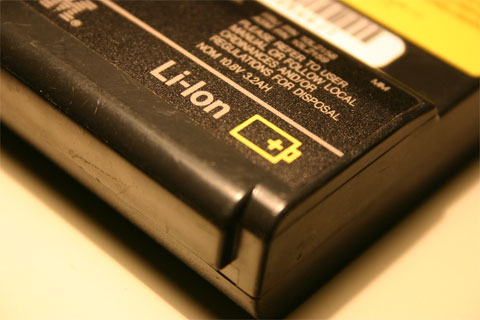 |
| a Lithium-Ion Battery |
Batteries of all kinds have one thing in common. They will eventually lose their ability to hold a charge. We will tackle about the different kinds of batteries and learn how to calibrate them for peak performance.
The NiCd (Nickel-Cadmium)
 |
| NiCd |
Nickel-Cadmium or commonly known as NiCd is one of the oldest rechargeable batteries invented. There is only one main disadvantage of NiCd batteries which is: With an NiCd battery, when you discharge it to about 20-25% then do a full charge (100%), and as time goes by, the NiCd cells will "forget" about the remaining 20-25% capacity that it can hold thus resulting a charge hold of 70-75% of it's full capacity. This "loss" of the battery's "memory" is called Memory Effect.
In simplier words, as the time goes on an NiCd battery, it loses its ability to measure its charge-holding capability thus requiring us to do a manual battery calibration to help get the lost "memory" back. This phenomenon does not occur due to excessive battery charging but rather it is due to the fact of not charging it to its full capacity.
Lithium - ion (Li-ion)
If you've bought yourself a smartphone/tablet/or a laptop, you're (most probably) running on a Lithium-ion battery. The most popular type of the rechargeables. Unlike NiCd, Lithium-ions doesn't have the "Memory Effect". Lithium-ions are more efficient, much smaller (NiCd in comparison), and has an exceptionally low cost. However Lithium-ions has their own drawbacks,
Although Li-ion does not have the bad Memory Effect, over time when it's not used properly, they can have the "cell mismatches" which results a calibrating confusion, which in concern due to the electronic battery management "brain" inside the batteries. This is why Apple recommends doing battery calibration (Their iDevices has the Li-ion batteries).
Heavy heat is one of the factor. For instance, if you use an iPod Touch for a 3D game, in an hour time it can get rather hot. This will result to a false battery detection rate (which in fact, happened to me which lead me to do this article). It would likely report a battery low notification (which is false).
Apple's explanation:
Lithium-ion polymer batteries pack in a higher power density than nickel-based batteries. This gives you a longer battery life in a lighter package, as lithium is the lightest metal. You can also recharge a lithium-ion polymer battery whenever convenient, without the full charge or discharge cycle necessary to keep nickel-based batteries at peak performance. (Over time, crystals build up in nickel-based batteries and prevent you from charging them completely,necessitating an inconvenient full discharge.) Source: Click Me
When to Calibrate?
If your battery bar on your device (be it a smartphone/laptop/tablet) tends to give highly unlikely "battery remaining time", although as I have said before all batteries lose their charge holding ability over time. Then it's time to do a battery calibration.How to calibrate?
1. Make sure your battery is charged at least 95% before proceeding.
2. Remove your AC Adapter (if plugged) and let your device run using the battery (drain it completely).
When your device gives out a low-battery warning, don't do anything on it. If on a Laptop, it automatically puts it to standby or sleep mode (don't do anything when this happens), and let it drain completely. The same applies to smartphones/tablets, don't do anything until it's turned off.
3. After your device has been completely turned off, plug your AC adapter and charge it to 100% (important)
That's it! One tip, in doing step 2, you can run processor-intensive tasks (i.e playing 3D games or watching HD video) to speed up the draining process.

No comments:
Post a Comment